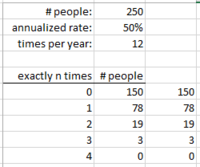S-Scitation
New member
- Joined
- Jun 11, 2019
- Messages
- 6
Hello All, am looking for some help explaining probability to drug test participants.
Basis 250 Employee, 50% of population sampling per year criteria approximately 11 selections per month
Trying to explain that 11 opportunities/month to be selected out of 250 employees is not 11/250 but rather 1/250,1/249, 1/248,1/247......1/241 etc. What is percent probability to be selected each month assuming name replacement? Looking for easy explanation to nervous people. Help appreciated
Basis 250 Employee, 50% of population sampling per year criteria approximately 11 selections per month
Trying to explain that 11 opportunities/month to be selected out of 250 employees is not 11/250 but rather 1/250,1/249, 1/248,1/247......1/241 etc. What is percent probability to be selected each month assuming name replacement? Looking for easy explanation to nervous people. Help appreciated

